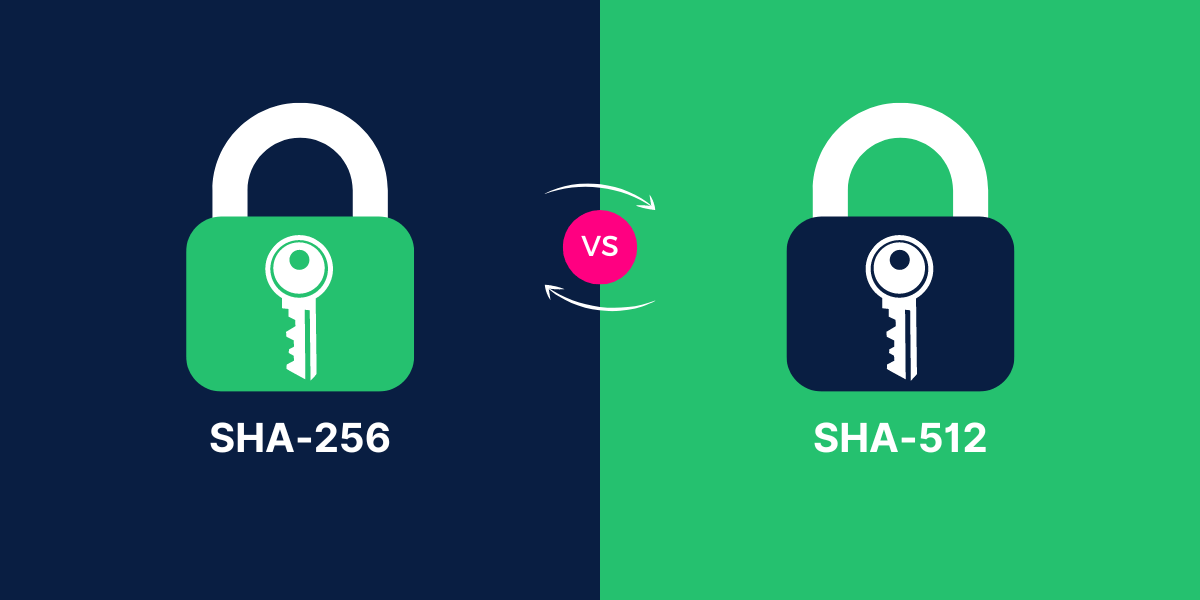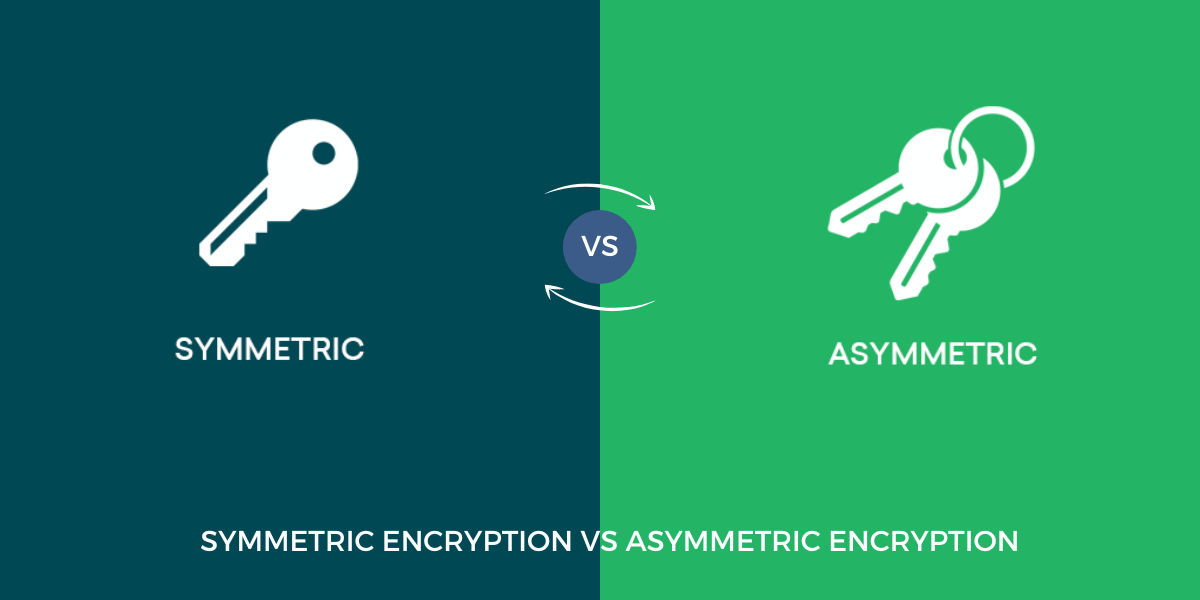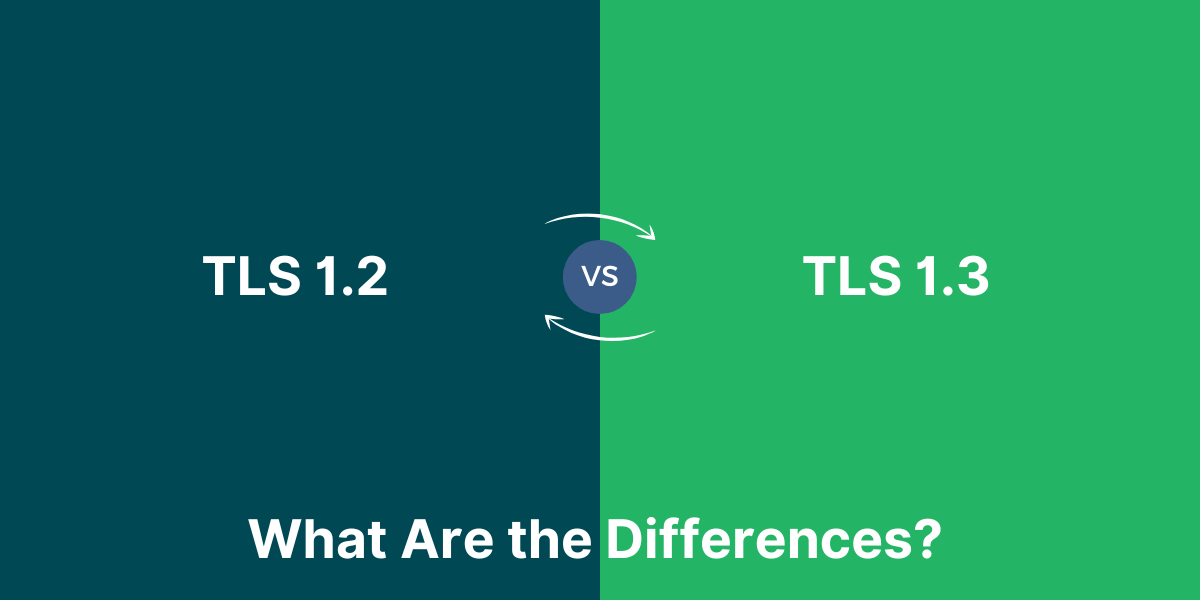What’s the Difference Between SHA 256 and SHA 512
Encryption algorithms play a crucial role in protecting sensitive data in transit and at rest. Two of the most widely used encryption algorithms are SHA-256 and SHA-512, which fall under the SHA-2 cryptographic hash function family. The SHA-256 and SHA-512 algorithms are part of the SHA-2 family and are widely used for data encryption and digital signatures. The choice between SHA-256 vs SHA-512 depends on the specific requirements of the application, the level of security needed, and the available computational resources.
Both SHA-256 and SHA-512 are secure, but they differ in the internals of how they operate and the levels of security they provide. This article will explore the key differences between SHA-256 and SHA-512 to help determine which Algorithm may be better suited for specific use cases.
SHA256 vs SHA512 : A Quick Comparison
|
Feature |
SHA-256 |
SHA-512 |
|
Hash Output Length |
256 bits |
512 bits |
|
Word Size |
32 bits |
64 bits |
|
Rounds |
64 |
80 |
|
Best Suited Architecture |
32-bit |
64-bit |
|
Software Performance |
Faster |
Slower |
|
Hardware Performance |
Good |
Better |
|
Security Margin |
128 bits |
256 bits |
|
Collision Resistance |
Good |
Better |
|
Preimage Resistance |
Good |
Better |
|
Second Preimage Resistance |
Good |
Better |
|
Brute Force Resistance |
Good |
Better |
|
Cryptanalysis Resistance |
Good |
Better |
|
Adoption Popularity |
Very High |
Moderate |
|
Supported Platforms |
Nearly Universal |
Very Broad |
|
Resource Usage |
Lower |
Higher |
What is SHA-256?
SHA-256 is a cryptographic hash algorithm which produces a 256-bit (32-byte) hash value. It is one of the most widely used SHA-2 algorithms in cryptographic applications such as digital signatures, message authentication codes, and other forms of authentication.
SHA-256 works by taking an input message of any length and generating an output of a fixed size. Even a small change in the input message will significantly change the hash output, making it very difficult to try to alter the input data without detection.
Key Properties of SHA-256
- 256-bit hash length
- 32-bit words utilized in its internal compression function
- 64 rounds of hashing
- Diffusion of influence where each bit of input affects multiple bits of output
- Near collision resistance against attacks
- Fast performance in software implementations
What is SHA-512?
SHA-512 is also a cryptographic hash function in the SHA-2 family, but it produces a longer 512-bit (64-byte) hash value. The Algorithm was originally designed for use with the SHA-1 hash function as SHA-512/256, but it is also commonly used standalone as SHA-512.
Key Properties of SHA-512
- 512-bit hash length
- 64-bit words utilized in its internal compression function
- 80 rounds of hashing
- Better diffusion of influence compared to SHA-256
- Stronger collision resistance versus SHA-256 against certain attacks
- Slower performance than SHA-256 in software but performs well in hardware
Key Technical Differences Between SHA-256 and SHA-512
Now that we have a general overview of SHA-256 and SHA-512 let’s explore some of the key technical differences between these two algorithms:
Hash Output Size
- SHA-256 generates a 256-bit hash value. This produces a 32-byte hex string as the output.
- SHA-512 generates a 512-bit hash value. This produces a 64-byte hex string as the output.
Word Size
- SHA-256 utilizes 32-bit words in its compression function. This matches well with 32-bit computer architectures.
- SHA-512 utilizes 64-bit words in its compression function. This provides more security but decreases performance on 32-bit CPUs.
Number of Rounds
- SHA-256 has 64 rounds of hashing in its compression function.
- SHA-512 has 80 rounds of hashing in its compression function.
Security Margin
- 128 bits of security for SHA-256
- 256 bits of security for SHA-512
Performance
- SHA-256 is faster than SHA-512 in software implementations.
- SHA-512 has better hardware performance optimizations than SHA-256.
Unique Attack Resistance
SHA-512 provides enhanced resistance to certain unique attacks that can impact SHA-256:
- Improved collision resistance versus length extension attacks compared to SHA-256.
- Better resistance to semi-freespace cryptanalysis which can be applied to SHA-256.
- More resilience against SHA-1 and MD5 style attacks targeting 32-bit words.
Strengths and Weaknesses Comparison
SHA-256 Strengths
- Very widely adopted, trusted standard that is ubiquitous across systems and languages.
- Optimized performance in software, fastest SHA-2 family member.
- Less resource intensive in terms of memory, CPU, etc.
- 256-bit hashes meet the security needs of most applications.
- Practical cryptographic weaknesses have yet to be found.
- Works efficiently across 32-bit and 64-bit system architectures.
SHA-256 Weaknesses
- The shorter hash output than SHA-512 is less future-proof.
- Some theoretical vulnerabilities against collision attacks compared to SHA-512.
- Potential risks from attacks like length extension or semi-free space cryptanalysis.
- Less security margin than SHA-512, 128 vs 256 bits.
SHA-512 Strengths
- A longer 512-bit Hash provides greater security, especially against brute force.
- Resilient against a wider range of cryptographic attacks that can impact SHA-256.
- More future-proof against advances in cryptanalysis and computing power.
- Optimized for efficient performance on 64-bit CPUs.
- 256 bits of security margin provides very robust protection.
SHA-512 Weaknesses
- Slower performance than SHA-256 on 32-bit systems.
- Larger memory and resource requirements.
- SHA-256 is more widely used and has less ubiquitous support.
- 512-bit hashes are overkill in many non-critical use cases.
- Requires 64-bit architecture to reach optimal performance.
Recommended Use Cases
So when should you use SHA-256 vs SHA-512? Here are some general recommendations on which Algorithm may be better suited for different use cases:
Use SHA-256 for
- General password and data hashing for platforms like web, mobile, IoT, etc.
- Digital signatures where the platform utilizes 32-bit architectures.
- HMAC authentication codes for typical applications.
- Verifying data integrity in common usages like SSL/TLS certificates.
- Most standard cryptographic usages where 256 bits provide adequate security.
Use SHA-512 for
- Cryptocurrency and blockchain applications that need long future-proof hashes.
- Digital signatures where the platform can optimize 64-bit performance.
- Very high-security environments like government, defense, and financial systems.
- Protecting extremely sensitive data like healthcare records, trade secrets, etc.
- Future-proofing where longevity of security is a priority.
- Any application where the extra security margin of SHA-512 is warranted.
Final Thoughts
SHA-256 and SHA-512 are two options in the SHA-2 cryptographic hash family, each with advantages depending on the use case.
For most general computing applications, SHA-256 is likely the better choice given its ubiquity, performance, and 256-bit security margin. It strikes a good balance between security and usability.
However, for applications dealing with very sensitive long-lived data, or where cryptographic longevity is critical, SHA-512 is likely the better choice given its increased security margins and robustness against a wider range of potential attacks.
Frequently Asked Questions
Is SHA-512 more secure than SHA-256?
Yes, SHA-512 is considered more secure overall than SHA-256 due to its larger 512-bit hash size, 64-bit words, increased rounds, and higher security margin against brute force attacks. Cryptanalysis research has also shown that SHA-512 has better resilience against certain types of theoretical collision attacks that can impact SHA-256. However, both are very secure, and SHA-256 remains an excellent choice for most use cases.
Is SHA-512 slower than SHA-256?
In general, SHA-512 performs slower than SHA-256 in software implementations on modern CPU architectures. This is because SHA-512 was designed for optimized performance on 64-bit CPUs. The 32-bit words used in SHA-256 map are better than those used on 32-bit computers. However, in hardware implementations leveraging GPUs, ASICs, or custom hardware, SHA-512 can match or exceed SHA-256 in performance.
Does SHA-512 use more resources?
Yes, SHA-512’s larger internal word size means it utilizes more memory, storage space, network bandwidth, and other resources to operate compared to SHA-256. The 512-bit hashes take up double the space of 256-bit hashes. This is a tradeoff for the increased security margin of SHA-512.
When would SHA-256 be preferred over SHA-512?
SHA-256 is preferred over SHA-512 in platforms utilizing 32-bit architectures, where software performance is critical or the 256-bit security margin is deemed sufficient. This includes many common applications, such as password hashing, digital signatures, data integrity, and authentication. The wide adoption of SHA-256 also makes it preferable for general interoperability.
When would SHA-512 be required over SHA-256?
SHA-512 may be required or strongly preferred for highly security-sensitive applications like government, defense, healthcare, financial systems, or any scenario where data protection is paramount. Its extra security margin, robustness against cryptanalysis, and ability to leverage 64-bit performance make it very appealing compared to SHA-256 for these use cases.
Does OpenSSL support SHA-512?
Yes, OpenSSL supports SHA-512, which can be used for applications managed through OpenSSL, such as digital certificates and signing operations. Depending on the desired Algorithm, OpenSSL allows the selection of either SHA-256 or SHA-512-based cryptographic functions.
Does PHP provide SHA-512 hashing?
Yes, PHP provides support for SHA-512 hashing through functions like Hash () and hash_hmac(), which allow for the specification of the desired Algorithm. The PHP hash() function can take ‘sha512’ as a parameter to perform a SHA-512 hash rather than the default SHA-256. PHP libs like Hash also provide SHA-512 classes.
Do Java and .NET languages support SHA-512?
Absolutely. Java provides SHA-512 support through classes like Message Digest, and C# .NET languages provide SHA-512 support through APIs like SHA512Managed. Nearly all modern languages and frameworks contain built-in functions or libraries to utilize SHA-512.

Priya Mervana
 Verified Web Security Experts
Verified Web Security Experts
Priya Mervana is working at SSLInsights.com as a web security expert with over 10 years of experience writing about encryption, SSL certificates, and online privacy. She aims to make complex security topics easily understandable for everyday internet users.



